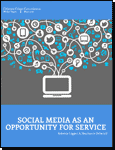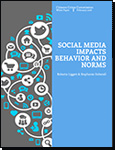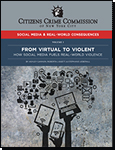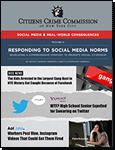
|
A non-partisan non-profit organization working to make criminal justice and public safety policies and practices more effective through innovation, research, and education. |
INITIATIVE Social Media Behavior & Real-World Consequences Social media now has billions of users worldwide. Facebook, Twitter and other emerging platforms are integral forms of communication in our daily lives. We use it to bridge friendships, raise awareness, express ourselves, and stay connected with the world around us. However, with all the advancements social media offers, it also comes with dangers. Increasingly frequent reports of hate speech, bullying, gang activity, crime, and violent extremism facilitated by social media use are shocking, troubling and often result in real-world consequences such as school disciplinary action, loss of employment, arrest, victimization, violent attacks, shootings, suicide, murder and acts of terrorism. As media reports have illustrated, social media interactions do not always stay in cyberspace. Often the ramifications of posted content spill into the real world. What at first seems like an unprovoked conflict is shown to have started or been inflamed on social media. This phenomenon is especially true as it relates to violence. In such cases, an unpredictable shooting is often foreshadowed by months of online fighting, bullying, and threatening "status updates"—warnings that were not visible off-line. Social media users witness these types of posts every day and often fail to intervene; instead, these behaviors are validated and reinforced when users "like" the posts or respond with encouraging comments, meant seriously or not. Tragically, some of the real-world consequences may well have been prevented if a "friend" or "follower" proactively responded to a post or photo, or if users were educated on safe social media habits which included steps on how to identify, assess, and respond to potentially dangerous content. The Crime Commission is engaged in several initiatives that seek to provide social media users with tools and information to help them stay safe both on- and off-line: Analysis To develop a comprehensive understanding of the problem and identify possible solutions, the Crime Commission is analyzing and researching the following questions:
Education The Crime Commission works with a variety of community-based anti-violence organizations which work directly with youth involved in gun violence. We created informational flyers and a 40-minute lesson plan in order to help these organizations educate youth on the potential dangers and consequences of posting content on social media, and how to protect themselves and others. The commission has also created resources for anti-violence organization staff, with tips on how to recognize and respond to harmful posts that can result in real-world violence, and how to maintain a professional social media presence. Innovation One of the findings from the Crime Commission's analysis is that youth involved in gangs and crews are taking to social media to taunt and threaten rivals, which often rapidly accelerates and amplifies conflicts among youth, and leads to deadly real-world violence. To address this growing problem, the Crime Commission worked with our NYC Cure Violence partners and Dr. Shabnam Javdani at the NYU Steinhardt Department of Applied Psychology to create a new, proactive response, called E-Responder. The commission believes that in order to prevent violent consequences of social media interactions, we must intervene where youth are engaging in this harmful behavior on social media. Therefore, E-Responder adapts effective in-person violence prevention interventions for use over social media. This innovative program trains community-based anti-violence organizations to monitor, assess, and respond to social media content that may lead to real-world violence. » read more about E-Responder |
Media & Resources
Reports
Social Media Statistics
|





